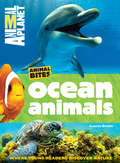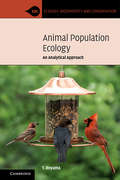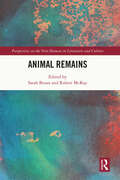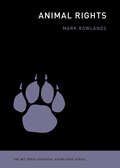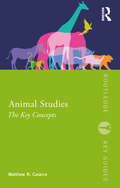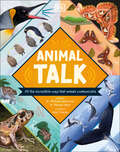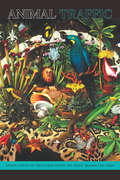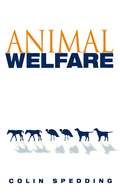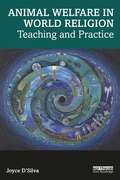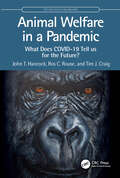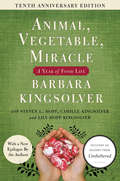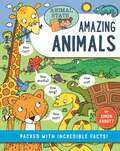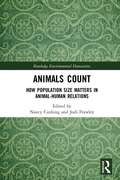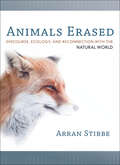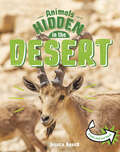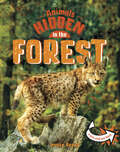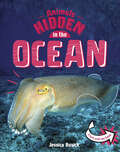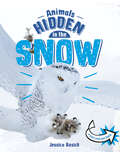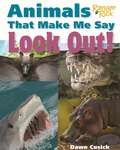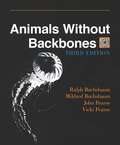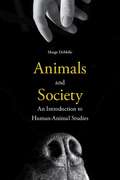- Table View
- List View
Animal Planet Ocean Animals (Animal Bites Series)
by Laaren Brown Animal PlanetWith more than 200 gorgeous animal photos of sharks, whales, clown fish, jelly fish, dolphins, and others, Animal Planet Ocean Animals is a fun, habitat-by-habitat guide that provides kids in the first years of schooling with the perfect bite-sized view of their favorite ocean-dwelling animals. Arranged thematically with focus on animal behavior and family relationships, young readers will explore sections about animal bodies, baby animals, food, play time, conservation and more. Special book features designed for this age group include Quick Bites sidebars with cool animal facts, simple infographics, and illustrated maps of Earth's watery environments.For more Animal Bites books, check out Animal Planet Polar Animals!A portion of the proceeds will benefit Animal Planet's R.O.A.R. (Reach Out. Act. Respond.) project which partners with leading animal organization to make the world a better place for domestic and wild animals.
Animal Planet Polar Animals (Animal Bites Series)
by Laaren Brown Animal PlanetWith more than 200 gorgeous animal photos of penguins, polar bears, sea lions, walruses, reindeer and others, Animal Planet Polar Animals is a fun, habitat-by-habitat guide that provides kids in the first years of schooling with the perfect bite-sized view of their favorite animals living in both polar climates. Arranged thematically with focus on animal behavior and family relationships, young readers will explore sections about animal bodies, baby animals, food, play time, conservation, and more. Special book features designed for this age group include Quick Bites sidebars with cool animal facts, simple infographics, and illustrated maps of the coldest places on Earth. For more Animal Bites books, check out Animal Planet Ocean Animals!A portion of the proceeds will benefit Animal Planet's R.O.A.R. (Reach Out. Act. Respond.) project which partners with leading animal organization to make the world a better place for domestic and wild animals.
Animal Population Ecology: An Analytical Approach (Ecology, Biodiversity and Conservation)
by T. RoyamaAnimal population ecology comprises the study of variations, regulation, and interactions of animal populations. This book discusses the fundamental notions and findings of animal populations on which most of the ecological studies are based. In particular, the author selects the logistic law of population growth, the nature of competition, sociality as an antithesis of competition, the mechanism underlying the regulation of populations, predator-prey interaction processes, and interactions among closely related species competing over essential resources. These are the notions that are considered to be well-established facts or principles and are regularly taught at ecology classes or introduced in standard textbooks. However, the author demonstrates that these notions are still inadequately understood, or even misunderstood, creating myths that would misguide ecologists in carrying out their studies. He delves deeply into those notions to reveal their real nature and draws a road map to the future development of ecology.
Animal Remains (Perspectives on the Non-Human in Literature and Culture)
by Robert McKay Sarah BezanThe dream of humanism is to cleanly discard of humanity’s animal remains along with its ecological embeddings, evolutionary heritages and futures, ontogenies and phylogenies, sexualities and sensualities, vulnerabilities and mortalities. But, as the contributors to this volume demonstrate, animal remains are everywhere and so animals remain everywhere. Animal remains are food, medicine, and clothing; extractive resources and traces of animals’ lifeworlds and ecologies; they are sites of political conflict and ontological fear, fetishized visual signs and objects of trade, veneration and memory; they are biotechnological innovations, and spill-over viruses. To make sense of the material afterlives of animals, this book draws together multispecies perspectives from literary criticism and theory, cultural studies, anthropology and ethnography, photographic and film history, and contemporary art practice to offer the first synoptic account of animal remains. Interpreting them in all their ubiquity, diversity and persistence, Animal Remains reveals posthuman relations between human and nonhuman communities of the living and the dead, on timescales of decades, centuries, and millennia.
Animal Rights (The MIT Press Essential Knowledge series)
by Mark RowlandsA fresh view of animals and what we owe them.Do animals have moral standing? Do they count, morally speaking? In Animal Rights, Mark Rowlands argues that they do and explores the implications of this idea. He identifies three different waves in animal rights writing. The first wave was defined by a traditional dispute between utilitarianism (represented by Peter Singer) and rights-based approaches (represented by Tom Regan) to ethics. The second wave was defined by an expansion in a conception of ethics, which saw utilitarian and rights-based approaches supplemented by other ethical traditions, including contractualism, virtue ethics, and care ethics. The third wave was defined by an expansion in our conception of animals, driven by exciting new developments in the field of comparative psychology.Each of these waves had ramifications for how we understand the moral status of animals, but, this book argues, and reinforces, the core idea that animals deserve moral respect. In earlier waves, discussions of animal ethics had been focused on the issue of animal suffering. But the third wave is defined by the idea that animals are far more than merely sufferers or enjoyers of experiences but are instead authors of their own lives: creatures capable of choosing how to live, shaped by a conception of their life and how they would like it to go. Rowlands writes that, no matter what moral theory you choose, the most plausible version of that theory entails that animals have moral standing and that our obligations to them are far more substantial than many of us care to acknowledge.
Animal Spaces, Beastly Places (Critical Geographies)
by Chris Philo Chris WilbertAnimal Spaces, Beastly Places examines how animals interact and relate with people in different ways. Using a comprehensive range of examples, which include feral cats and wild wolves, to domestic animals and intensively farmed cattle, the contributors explore the complex relations in which humans and non-human animals are mixed together. Our emotions involving animals range from those of love and compassion to untold cruelty, force, violence and power. As humans we have placed different animals into different categories, according to some notion of species, usefulness, domesticity or wildness. As a result of these varying and often contested orderings, animals are assigned to particular places and spaces. Animal Spaces, Beastly Places shows us that there are many exceptions and variations on the spatiality of human-animal spatial orderings, within and across cultures, and over time. It develops new ways of thinking about human animal interactions and encourages us to find better ways for humans and animals to live together.
Animal Studies: The Key Concepts (Routledge Key Guides)
by Matthew R. CalarcoPrefaced with a brief introduction to the field of animal studies, the text explores the key influential terms, topics and debates which have had a major impact on the field, and that students are most likely to encounter in their animal studies classes. Animal Studies provides a guide to key concepts in the burgeoning interdisciplinary field of animal studies, laid out in A-Z format. While Human–Animal Studies and Critical Animal Studies are the main frameworks that inform the bulk of the writings in animal studies and the key concepts discussed in the volume, other approaches such as anthrozoology and cognitive ethology are also explored. The entries in the volume attend to the differences in ongoing debates among scholars and activists, showing that what is commonly called “animal studies” is far from a unified body of work. A full bibliography of sources is included at the end of the book, along with an extensive index. The book will be a valuable guide to undergraduate and postgraduate students in geography, philosophy, sociology, anthropology, women’s studies, and other related disciplines. Seasoned researchers will find the book helpful, when researching topics outside of their specialization. Outside of academia, it will be of interest to activists, as well as professional organizations.
Animal Talk: All the Incredible Ways that Animals Communicate (Wonders of Wildlife )
by Dr Michael Leach Meriel LlandThis animal book explores the many clever and creative ways animals communicate with each other, from head-turning howls to jaw-dropping dances.For many animals, communicating is as important to their life chances as finding food and water. Animal Talk is a brilliant introduction to ingenious communication strategies in the natural world.Whether it's releasing a cloud of ink to confuse, roaring to intimidate, dancing to attract a mate or howling to locate one another, the range of messaging methods in the natural world is quite astonishing (and sometimes quite disgusting!). Perfect for children aged 7–9, the animal book is filled with intriguing illustrations and spectacular photographs of the amazing, obscure, and unusual. You'll never look at nature the same way again!This captivating animal book for children offers: - A fascinating array of animal communications from a wide variety of different species for children aged 7-9.- Expertly written text and accompanying images to clearly explain each animal communication.- Several sections which break down different animal themes, such as sounds, scents, and signals to make the content easy to understand.- Incredible facts about how animals communicate – including how elephants communicate over huge distances by listening through the soles of their feet, how whales communicate through song, and more.Meet birds and spiders who dance to attract a mate, vultures that are sick on their own food to put off other animals, lions who roar at rival prides to test out their strength, and many more. Animal Talk is a must-have for the animal-obsessed, as well as making an interesting resource for school and libraries. At DK, we believe in the power of discovery. So why not complete the collection?If you liked Animal Talk and finding out about the creative ways that animals communicate with each other, why not check out the other intriguing animal title in the series? How Not To Get Eaten is a book about the many clever ways animals protect themselves from predators in the wild!
Animal Teams: How Amazing Animals Work Together in the Wild
by Charlotte MilnerThis non-fiction children&’s book explains how animals work together to survive and thrive in the wild. It teaches children how important teamwork is, no matter how big or small a creature you are.Charlotte Milner's stunning illustrations blend with photographs to create engaging animal scenes that children will love to pore over again and again.Discover why teamwork is so important for different groups of animals in the wild. Inside this animal book for children, you&’ll find: • A stunning picture book that introduces children to a range of different animal groups, including a pack of wolves, flock of birds and school of fish • A range of habitats, including mountains, coral reefs and the Amazon rainforest • Stunning illustrations by award-winning author and illustrator Charlotte Milner, who wrote and illustrated The Bee Book series • Engaging text introduces children to different types of animal groups and how they work together in the wild Have you ever asked why birds swoop and soar in a flock? Or wondered where an army of ants is marching? This beautiful animal book takes young readers through a range of habitats, from snowy mountains to colorful coral reefs, to discover different groups of animals and how they work together to survive in their environments. Children will learn fascinating fun facts along the way. For example, did you know that a group of monkeys is called a troop? Or that flying in flocks means birds can sleep as they fly? Combined with gentle learning and simple, lyrical text, Animal Teams is perfect for reading aloud which presents many early learning benefits including language development.This exquisite children&’s educational book is unique in its ability to educate little ones about the animal kingdom while also teaching them about the importance of teamwork in their own lives.
Animal Traffic: Lively Capital in the Global Exotic Pet Trade
by Rosemary-Claire CollardParrots and snakes, wild cats and monkeys---exotic pets can now be found everywhere from skyscraper apartments and fenced suburban backyards to roadside petting zoos. In Animal Traffic Rosemary-Claire Collard investigates the multibillion-dollar global exotic pet trade and the largely hidden processes through which exotic pets are produced and traded as lively capital. Tracking the capture of animals in biosphere reserves in Mexico, Guatemala, and Belize; their exchange at exotic animal auctions in the United States; and the attempted rehabilitation of former exotic pets at a wildlife center in Guatemala, Collard shows how exotic pets are fetishized both as commodities and as objects. Their capture and sale sever their ties to complex socio-ecological networks in ways that make them appear as if they do not have lives of their own. Collard demonstrates that the enclosure of animals in the exotic pet trade is part of a bioeconomic trend in which life is increasingly commodified and objectified under capitalism. Ultimately, she calls for a “wild life” politics in which animals are no longer enclosed, retain their autonomy, and can live for the sake of themselves.
Animal Welfare
by Sir Colin SpeddingAwareness of the use of animals in human society in fields such as farming, biotechnology and sport is dogged by the lack of a clear and objective exposition of the issues involved and a sense of possible conflict between human and animal welfare. This text addresses these dilemmas - what is the actual scale of the animal welfare problem; where does responsibility begin; what positive steps are actually being taken to alleviate animal suffering; and can a rational and compelling argument be given for the importance of animal welfare. It therefore aims to offer a comprehensive guide to the uninformed as well as those who have knowledge of the issues but lack conviction.
Animal Welfare in World Religion: Teaching and Practice
by Joyce D'SilvaThis unique and readable book examines the relationship between religion and animal welfare, taking a detailed dive into the teachings and practices of the major world religions. While there are many books expounding the beliefs of the major religions and many about the rights and welfare of animals, there are few linking the two. With each chapter focusing on one of the five major religions – Judaism, Christianity, Islam, Hinduism and Buddhism – the book explores the beliefs and practices which drive our relationship with and treatment of animals. The book draws on the scriptures of the major faiths and includes the voices of leading historical religious figures and contemporary faith leaders. In doing so, it compares the teachings of old with contemporary practices and showcases the impact of the major religions on both the protection and exploitation of animals, from running animal sanctuaries, to participating in or condoning cruel sports and factory farming. Importantly, the book also includes a chapter looking beyond the major world religions, where it examines a wider range of beliefs and practices, including Indigenous peoples from the USA and Australia, Jainism, Sikhism and Rastafarianism, to provide fascinating insights into another range of beliefs and views on the human-animal relationship. Overall, this book challenges and encourages religious leaders and followers to re-examine their teachings and to prioritise the well-being of animals. This book is essential reading for those interested in the role of religion in animal welfare, human-animal studies, and animal welfare and ethics more broadly.
Animal Welfare in a Pandemic: What Does COVID-19 Tell us for the Future? (CRC One Health One Welfare)
by John T. Hancock Ros C. Rouse Tim J. CraigAnimal Welfare in a Pandemic explores the impact of COVID-19 on a wide array of animals, from those in the wild to companion and captive animals. During the height of the pandemic, a range of animals were infected, and many died, but this was hard to predict, even using up-to-date bioinformatics. Lockdowns around the world had, and continue to have, a major effect on animals’ welfare, influencing pet ownership and care, as well as impacting on the work of conservation institutes due to the lack of visitors and funding and lack of tourist presence in the wild which impacted on anti-poaching efforts. Some of the vast amount of personal protection equipment (PPE) that was distributed was discarded, creating both dangers and occasional opportunities for wild animals. With the rollout of human vaccines, some countries started developing animal vaccines, only some of which were deployed. In summary, the pandemic had a wide-ranging influence on animal welfare around the world. This is reviewed to highlight what can be learned to protect and enhance animal welfare in future epidemics/pandemics, and contribute to a genuinely One Health approach where the health and welfare of both humans and animals are considered holistically.This book is authored by members of the University of the West of England, Bristol, who span a range of expertise in Biological Sciences, Social Sciences, Animal Welfare, and Ethics.
Animal, Vegetable, Miracle - 10th anniversary edition: A Year of Food Life
by Barbara Kingsolver Steven L. Hopp Camille Kingsolver Lily Hopp Kingsolver“A profound, graceful, and literary work of philosophy and economics, well tempered for our times, and yet timeless. . . . It will change the way you look at the food you put into your body. Which is to say, it can change who you are.” — Boston GlobeA 10th anniversary edition of Barbara Kingsolver's New York Times bestseller that describes her family's adventure as they move to a farm in southern Appalachia and realign their lives with the local food chainSince its publication in 2007, Animal, Vegetable, Miracle has captivated readers with its blend of memoir and journalistic investigation. Updated with original pieces from the entire Kingsolver clan, this commemorative edition explores how the family's original project has been carried forward through the years.When Barbara Kingsolver and her family moved from suburban Arizona to rural Appalachia, they took on a new challenge: to spend a year on a locally-produced diet, paying close attention to the provenance of all they consume. Concerned about the environmental, social, and physical costs of American food culture, they hoped to recover what Barbara considers our nation's lost appreciation for farms and the natural processes of food production. Since 2007, their scheme has evolved enormously. In this anniversary edition, featuring an afterword by the entire Kingsolver family, Barbara's husband, Steven, discusses how the project grew into a farm-to-table restaurant and community development project training young farmers in their area to move into sustainable food production. Camille writes about her decision to move back to a rural area after college, and how she and her husband incorporate their food values in their lives as they begin their new family. Lily, Barbara's youngest daughter, writes about how growing up on a farm, in touch with natural processes and food chains, has shaped her life as a future environmental scientist. And Barbara writes about their sheep, and how they grew into her second vocation as a fiber artist, and reports on the enormous response they've received from other home-growers and local-food devotees.With Americans' ever-growing concern over an agricultural establishment that negatively affects our health and environment, Animal, Vegetable, Miracle is a modern classic that will endure for years to come.
Animals (Animal Stats)
by Simon AbbottDo you think you're an animal expert? Get the stats on the BIGGEST, the smallest, the fastest, the LOUDEST and much more!Packed with fascinating facts, stats and data, curious kids will be amazed to learn about the millions of animal species that share our planet, as well as habitats, animal adaptations and how to help our planet's biodiversity. Simon Abbott's fun characters draw in curious minds by answering the science and numeracy questions kids want to know, with the super-impressive answers found in nature!The Animal Stats series features accessible text paired with bright, colourful artwork, ideal for readers aged 6+, and includes a creature quiz at the back of the book to test their knowledge. Other titles in the series include Minibeasts, Sea Life and Dinosaurs.
Animals Count: How Population Size Matters in Animal-Human Relations (Routledge Environmental Humanities)
by Nancy Cushing Jodi FrawleyWhether their populations are perceived as too large, just right, too small or non-existent, animal numbers matter to the humans with whom they share environments. Animals in the right numbers are accepted and even welcomed, but when they are seen to deviate from the human-declared set point, they become either enemies upon whom to declare war or victims to be protected. In this edited volume, leading and emerging scholars investigate for the first time the ways in which the size of an animal population impacts how they are viewed by humans and, conversely, how human perceptions of populations impact animals. This collection explores the fortunes of amphibians, mammals, insects and fish whose numbers have created concern in settler Australia and examines shifts in these populations between excess, abundance, equilibrium, scarcity and extinction. The book points to the importance of caution in future campaigns to manipulate animal populations, and demonstrates how approaches from the humanities can be deployed to bring fresh perspectives to understandings of how to live alongside other animals.
Animals Erased: Discourse, Ecology, and Reconnection with the Natural World
by Arran Stibbe“Amazingly clear and incisive readings of a wide range of discourses related to animals and ecology” from the author of Ecolinguistics (Karla Armbruster, coeditor of Beyond Nature Writing).Animals are disappearing, vanishing, and dying out—not just in the physical sense of becoming extinct, but in the sense of being erased from our consciousness. Increasingly, interactions with animals happen at a remove: mediated by nature programs, books, and cartoons; framed by the enclosures of zoos and aquariums; distanced by the museum cases that display lifeless bodies. In this thought-provoking book, Arran Stibbe takes us on a journey of discovery, revealing the many ways in which language affects our relationships with animals and the natural world. Animal-product industry manuals, school textbooks, ecological reports, media coverage of environmental issues, and animal-rights polemics all commonly portray animals as inanimate objects or passive victims. In his search for an alternative to these negative forms of discourse, Stibbe turns to the traditional culture of Japan. Within Zen philosophy, haiku poetry, and even contemporary children’s animated films, animals appear as active agents, leading their own lives for their own purposes, and of value in themselves.“Those of us of cultures of the land—both working with and, yes, consuming animals—will applaud Arran Stibbe’s analysis of the loss of soul when right relationship is discarded.” —Alastair McIntosh, author of Soil and Soul
Animals Hidden in the Desert (Animals Undercover)
by Jessica RusickSome desert creatures are masters of disguise! They use camouflage and cover to outsmart predators or sneak up on prey. Some desert animals blend in with rocks, sand, and more. Others burrow beneath the ground or hide in shrubs. Can you spot the creatures hidden in the desert?
Animals Hidden in the Forest (Animals Undercover)
by Jessica RusickSome forest creatures are masters of disguise! They use camouflage and cover to outsmart predators or sneak up on prey. Some forest animals blend in with leaves, moss, and more. Others hide beneath rocks or in logs. Can you spot the creatures hidden in the forest?
Animals Hidden in the Ocean (Animals Undercover)
by Jessica RusickSome ocean creatures are masters of disguise! They use camouflage and cover to outsmart predators or sneak up on prey. Some ocean animals blend in with sand, pebbles, and more. Others hide in coral reefs or beneath the ocean floor. Can you spot the creatures hidden in the ocean?
Animals Hidden in the Snow (Animals Undercover)
by Jessica RusickSome creatures are masters of disguise! They use camouflage and cover to outsmart predators or sneak up on prey. In cold habitats, animals blend in with the snowy surroundings. They also hide beneath the snow in dens. Can you spot the creatures hidden in the snow?
Animals That Make Me Say Ewww! (Animals That Make Me Say...)
by Dawn CusickThat&’s so gross! Prepare to be grossed out by an engaging and unique look at some of the more disgusting survival techniques from the animal kingdom. From blood-squirting reptiles to blood-sweating mammals to nose-picking primates, learn about some of the most disgusting creatures in the animal kingdom. Author Dawn Cusick and the National Wildlife Federation compile a volume as attractive as its subject is disgusting.
Animals That Make Me Say Look Out! (Animals That Make Me Say...)
by Dawn CusickHey! Look out! Sharp-eyed readers will need to keep their eyes peeled in this engaging look at how animals of all shapes and sizes blend in and survive in their native ecosystems. How do animals deal with danger? From crocodiles standing on their tails to great white sharks with their jaws wide open to well-camouflaged venomous snakes, prospective naturalists and conservationists will have a lot to look out for in this exploration of dynamic ecosystems and the animals that hide and hunt in them. Back matter includes glossary, curated reading list and a scavenger hunt.
Animals Without Backbones: An Introduction to the Invertebrates (New Plan Texts at the University of Chicago)
by John Pearse Ralph Buchsbaum Mildred Buchsbaum Mildredd BuchsbaumAnimals Without Backbones has been considered a classic among biology textbooks since it was first published to great acclaim in 1938. It was the first biology textbook ever reviewed by Time and was also featured with illustrations in Life. Harvard, Stanford, the University of Chicago, and more than eighty other colleges and universities adopted it for use in courses. Since then, its clear explanations and ample illustrations have continued to introduce hundreds of thousands of students and general readers around the world to jellyfishes, corals, flatworms, squids, starfishes, spiders, grasshoppers, and the other invertebrates that make up ninety-seven percent of the animal kingdom. This new edition has been completely rewritten and redesigned, but it retains the same clarity and careful scholarship that have earned this book its continuing readership for half a century. It is even more lavishly illustrated than earlier editions, incorporating many new drawings and photographs. Informative, concise legends that form an integral part of the text accompany the illustrations. The text has been updated to include findings from recent research. Eschewing pure morphology, the authors use each group of animals to introduce one or more biological principles. In recent decades, courses and texts on invertebrate zoology at many universities have been available only for advanced biology majors specializing in this area. The Third Edition of Animals Without Backbones remains an ideal introduction to invertebrates for lower-level biology majors, nonmajors, students in paleontology and other related fields, junior college and advanced high school students, and the general reader who pursues the rewarding study of the natural world.
Animals and Society: An Introduction to Human-Animal Studies
by Margo DeMelloConsidering that much of human society is structured through its interaction with non-human animals, and since human society relies heavily on the exploitation of animals to serve human needs, human–animal studies has become a rapidly expanding field of research, featuring a number of distinct positions, perspectives, and theories that require nuanced explanation and contextualization. <P><P>The first book to provide a full overview of human–animal studies, this volume focuses on the conceptual construction of animals in American culture and the way in which it reinforces and perpetuates hierarchical human relationships rooted in racism, sexism, and class privilege. Margo DeMello considers interactions between humans and animals within the family, the law, the religious and political system, and other major social institutions, and she unpacks the different identities humans fashion for themselves and for others through animals. Essays also cover speciesism and evolutionary continuities; the role and preservation of animals in the wild; the debate over zoos and the use of animals in sports; domestication; agricultural practices such as factory farming; vivisection; animal cruelty; animal activism; the representation of animals in literature and film; and animal ethics. Sidebars highlight contemporary controversies and issues, with recommendations for additional reading, educational films, and related websites. DeMello concludes with an analysis of major philosophical positions on human social policy and the future of human–animal relations.
